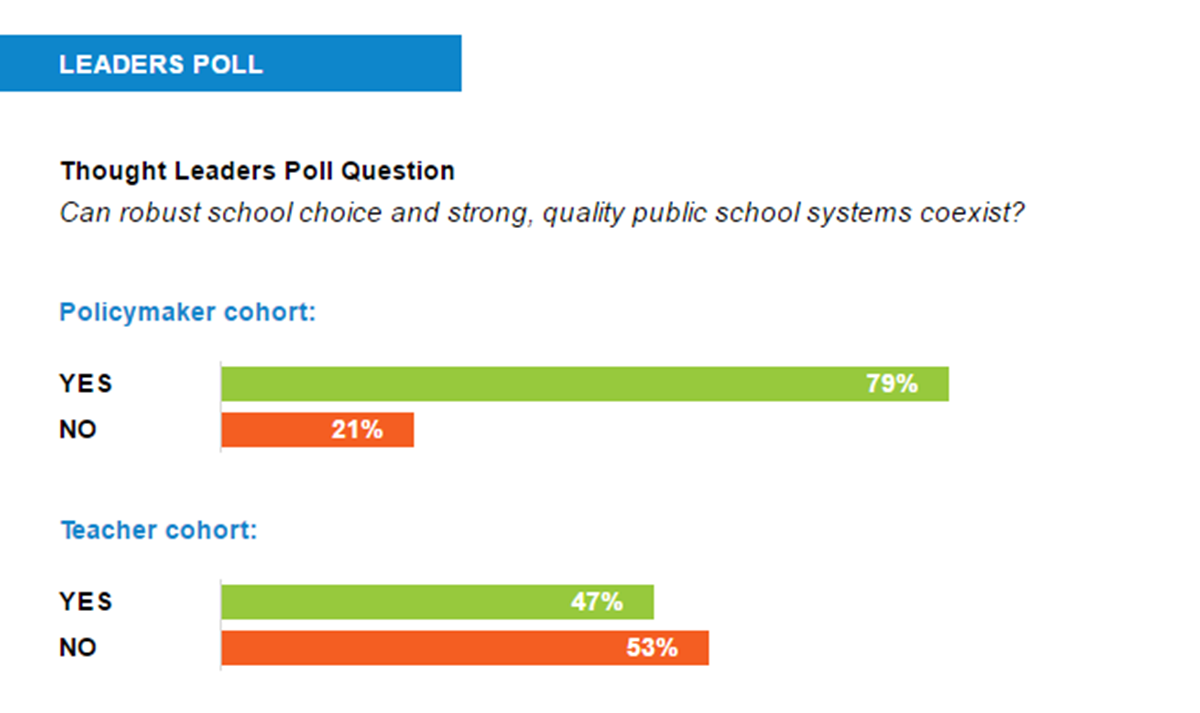Thought leaders: School choice or strong public schools – can you have both?
In the swirl of controversy surrounding the confirmation of Education Secretary Betsy DeVos, it was presented as a stark decision: America could either have robust school choice or strong public schools. But does it have to be that way?
For our first EqualEd poll, we asked thought leaders both in the classroom and out whether they thought it was possible to have both. The poll is a way to get a range of expert voices on the key issues tied to education equality; it isn't trying to capture the consensus opinion among the education community.
Seventy-nine percent of policy influencers who responded to our poll said yes, as long as a school system was properly set up and regulated, students could benefit from school choice options like charters and private schools competing with traditional public schools, and sharing best practices. Their two biggest caveats were that all schools had to have equal accountability and that there were limits on private school vouchers. Meanwhile, teachers were more skeptical, with their main argument being that school choice drains funding from public schools because money follows children to whichever school they go.
While funding is often the main bone of contention traditional public school advocates have with charters, Patrick Riccards, author of the Eduflack blog and the chief communications and strategy officer for the Woodrow Wilson Foundation, echoes the common school choice rebuttal that the presence of charters creates healthy competition.
“Done properly, school choice can drive all public schools to improve, meeting the needs of the families seeking alternative paths,” writes Mr. Riccards.
“School choice can be a robust component of a strong public school system in an urban area with sufficient density to allow meaningful choice. Clearly this is the case for public school choice, as many systems such as New York City have thriving charter systems as well as effective public schools,” writes Adam Gamoran, president of the William T. Grant Foundation. “By contrast, public support for private school choice carries more dangers for the public school system; if such support is not means-tested then it is little more than a transfer of public funds to the private sector. As long as support is provided in limited amounts and in a means-tested way, private school choice need not threaten the viability of strong public schools.”
However, others like Jonathon Plucker, the Julian C. Stanley Professor of Talent Development at Johns Hopkins University, pointed out that given the different kinds of schools that fall under the school choice umbrella, it is not easy to generalize about the effects those schools will have.
“Choice comes in many shapes and sizes,” he says. “For example, open enrollment, charters, magnets, and vouchers are all forms of choice, but they can each have very different interactions with traditional public school systems.”
Even with just one of those school types, there can be great variation. For example, the strongly regulated charter schools in Massachusetts have generally been academically successful and, in some places like the Lawrence turnaround districts, fulfilled their original purpose of sharing best practices with traditional public schools. On the other hand, the network of charters, including for-profit ones, in Michigan hurt the state system as whole as they were badly regulated and underperformed academically.
The ideal coexistence of school choice institutions and traditional public schools occurs when districts move beyond labels, argues Jim Balfanz, President of City Year, the AmeriCorps national service organization.
“Schools work when we see past governance structures and school types, and focus on quality, accountable, safe, and healthy learning environments that produce results for students,” Mr. Balfanz writes. “When these elements are in place, as they are in many schools across the United States, everyone benefits – students, communities, and our national economy.”
The view from the classroom
When we asked teachers in our Thought Leaders poll whether robust school choice and strong public schools could coexist, Funding was the No. 1 reason they cited for being skeptical.
“Since the one drains the funding from the other it puts public education on a downward spiral,” writes Brett Bigham, 2014 Oregon Teacher of the Year.
Another teacher who chose to remain anonymous, believes it is possible, but with the caveat that school choice must be just that -- with schools truly open to all and not covertly using strict discipline to “weed out” students who might place a drag on test averages.
“This is possible if all children have access to the educational choice that is best for them,” the teachers writes. “If the charter schools do not take an equal representation of ALL students (gender, ethnicity, religion, special ed. status, English Language Learners, etc.) then it will not be equitable.”
Leah Luke, a high school teacher from rural Wisconsin and previous winner of the Badger State’s teacher of the year award, pointed out how school choice can have an outsized financial disruption in districts like hers.
“School choice in a small, rural setting has a negative impact on the public system. The loss of even one or two students to school choice can reduce program offerings for the remaining students,” she says. “In the first rural high school I taught in at the beginning of my career, a large graduating class had 25 students. The smallest graduating class during my tenure at that high school was 18. Since the ‘money follows the student,’ the loss of $8,000-$10,000 per student was huge.”
“Then there is the issue of supplies. How do you plan for the purchase of textbooks, 1:1 devices, bus routes, and boxes of Kleenex? Again, please view through the lenses of small districts,” she adds.





